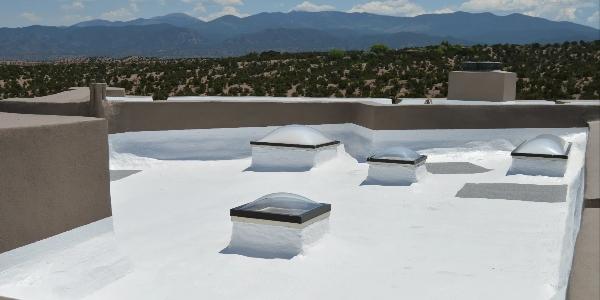UP TO THE MINUTE
Silicone versus acrylic coatings
By Emma Peterson.
Find the right product for your next project with this analysis of material use cases.
When it comes to roof coatings, there are many different options for materials and products on the market. Chris Kuykendall from Mule-Hide Products spoke to Heidi J. Ellsworth in this episode of CoatingsTalk about two of the main coating options on the market and when to use each to get the most success.
He shared that there are multiple factors to consider when choosing which coating is the right option for the job – regional, budget, roof performance. Silicone coatings are the market lead in terms of sales for Mule-Hide and most other manufacturers in the industry. Chris explained the primary use-case for this type of coating, saying, “When we have high rainfall regions, and maybe we have a roof where there is a little bit of ponding there, we like to see silicone in that.”
But he points out the importance of considering how the rooftop is being used and if it’s a high traffic area for maintenance personnel and other foot traffic, as silicone can get very slippery when wet. While there are things that can be done to modify the silicone system to make it more slip resistant, such as adding granules to a coating, Chris explained that there are special factors to consider, such as increasing the thickness of the applied coating. He explained, “When you introduce something for an aggregate like a granule into that, you can impact that process of it binding to itself and truly becoming monolithic. So, you need to check with your manufacturer and really get a good plan.”
Even with silicone’s lead in the industry, Chris noted, “Acrylic still has a strong place in the market, urethanes, even asphalt emulsion coatings and things like that.” In contrast to the suggestion of silicone in wetter regions, Chris said that acrylics work great in drier climates. He also pointed out that low solids acrylics can be very beneficial on big industrial metals, “If you're trying to do high solid silicone on big industrial metal, that is going to be a bit of a headache for you. Low solids acrylic can be run and flow across that metal panel.”
Overall, Chris said there were benefits to both silicone and acrylic coatings. In the end it’s a case-by-case basis, "With coatings we must be creative, and while we're standardized and specified, we still have to be creative in how we use these products to deliver the best value.
Read the transcript, Listen to the podcast or Watch the whole episode to learn about when and how to apply coatings to a roof system.
Learn more about MuleHide Products in their Coffee Shops Directory or visit www.mulehide.com.

About Emma
Emma Peterson is a writer at The Coffee Shops and AskARoofer™. Raised in the dreary and fantastical Pacific Northwest, she graduated in 2024 from Pacific University in Oregon with a degree in creative writing and minors in graphic design and Chinese language. Between overthinking everything a little bit, including this bio, she enjoys watching movies with friends, attending concerts and trying to cook new recipes.





















Comments
Leave a Reply
Have an account? Login to leave a comment!
Sign In